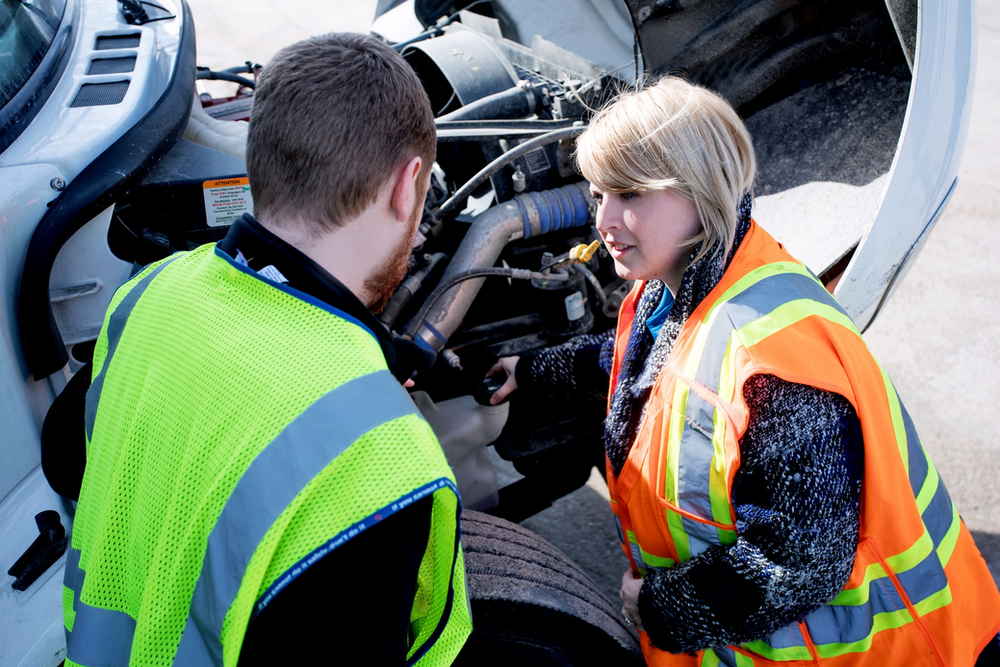
Commercial truck drivers have a responsibility to keep Canadian roads and highways safe by making sure their vehicles are in good operating condition. The best and most effective way to do this is with a pre-trip truck inspection (also called a daily vehicle inspection or circle check).
This isn’t just a best practice, it’s a responsibility under the law. As per the Highway Traffic Act, drivers must inspect their vehicles and be able to determine if it is in safe operating condition.
As part of a Class A or D road test, aspiring commercial truck drivers must demonstrate, through a pre-trip inspection, that they are capable of determining if a vehicle is in safe operating condition, as well as identifying any minor or major defects.
According to the Commercial Vehicle Safety Alliance (CVSA), over 20% of the 50,000 commercial vehicle inspections conducted during the 2020 International Roadcheck event, the largest targeted enforcement program on commercial vehicles in the world, resulted in a vehicle being taken out of service because of safety violations —that’s more than 10,000 vehicles with major defects.
Nearly 40% of these were taken out of service because of safety issues related to the vehicle’s brake system or brake adjustment. Considering that brakes are one of the foundations of driver safety (if not the foundation), these results are pretty scary. Other top violation categories included issues related to tires, lights, and cargo securement.
Pre-trip Inspections In Canada
In Canada, a commercial truck driver is required to complete a pre-trip truck inspection every 24 hours and to monitor the vehicle’s condition throughout the trip. Drivers must carry both the current inspection report and the inspection schedule.
A driver is not permitted to drive a truck unless a Schedule 1 inspection of the vehicle has been conducted within 24 hours. The Schedule 1 inspection report provides a list of vehicle systems and components that a driver is required to inspect, as well as a list of defects to guide and assist the driver.
Defects are divided into two categories: major and minor. Identifying major and minor commercial vehicle defects is covered in-depth in the KnowledgeSurge certified Commercial Trucking AZ Program.
When a minor defect is identified, the driver must record the defect on the inspection report and report it to the operator. Drivers are not permitted to drive a vehicle with a major defect.
How To Perform A Pre-trip Inspection
Drivers may choose an inspection procedure (circle procedure or walk-around) that best suits the vehicle and its location. The order in which you inspect vehicle components doesn’t matter, as long as each item on the inspection schedule is inspected.
The defects that are discovered must be recorded, and you must notify the operator of all defects. For minor defects, such as broken clearance lights, you just need to notify the operator so that repairs can be done; however, major defects must be repaired before you operate the vehicle again.
The most common reason for taking a commercial vehicle out of service is for out-of-adjustment air brakes. In addition to being unsafe, out-of-adjustment air brakes can result in the vehicle being detained or even the suspension or cancellation of your operator’s CVOR certificate.
A thorough air brake pre-trip inspection is crucial before starting your trip; unless you are a certified mechanic, or have completed an approved air brake adjustment course, you cannot adjust your own air brakes.
Pre-Trip Inspection Checklist
Here is an example of a pre-trip inspection checklist. Note that the components and systems you will be required to check may vary depending on the type of vehicle being inspected.
-
Air brake system (if applicable)
-
Cab
-
Cargo securement (if present)
-
Coupling devices (if equipped)
-
Dangerous goods
-
Driver controls
-
Driver seat
-
Electric brake system
-
Emergency equipment and safety devices
-
Exhaust system
-
Frame and cargo body
-
Fuel system
-
Glass and mirrors
-
Heater / Defroster
-
Horn
-
Hydraulic brake system
-
Lamp and reflectors
-
Steering
-
Suspension system
-
Tires
-
Wheels, hub, and fasteners
-
Windshield wiper / washer
For information about a career in commercial trucking in Canada, including the median truck driver salary in Canada, how to get an AZ license, how much it costs to become a truck driver or how to get your air brake endorsement, visit KnowledgeSurge.com.


